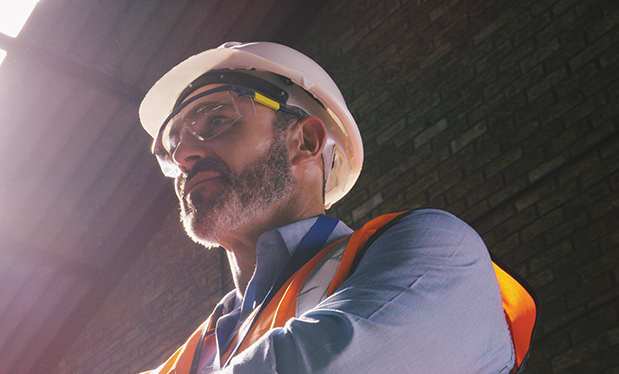Founded in 1874 with 44 families, Temple Beth-El in San Antonio is the oldest synagogue in South Texas. A founding member of the Union of American Hebrew Congregations, now the Union of Reform Judaism, the congregation outgrew its original building and constructed a new one in 1903 on the same site in downtown San Antonio at the corner of Jefferson and Travis streets.
Following significant growth, in 1927, Temple Beth-El moved north to another new building at the corner of Belknap and Ashby. The iconic landmark still is used and serves nearly 1,000 families. One of the few synagogues in the U.S. with an all-female clergy, Temple Beth-El remains relevant with a large Religious and Hebrew School, active youth groups and a robust adult education program.
On April 12, 2016, the costliest hailstorm in Texas history, according to the Insurance Council of Texas, damaged the temple’s iconic clay tile dome. Later that month, members of Temple Beth-El’s Executive Committee contacted Beldon Roofing Co., San Antonio, for a proposal to restore the dome.
“We were honored by the opportunity and excited about the challenges to restore the San Antonio landmark,” says Brad Beldon, chief culture officer and CEO of Beldon Roofing. “My family has belonged to Temple Beth-El since 1946 when my grandfather, Morris Beldon, moved to San Antonio from Boston after being stationed twice at Fort Sam Houston.”
Damage assessment
Beldon Roofing subsequently was awarded the project and began work on the 8,700-square-foot dome in October 2018. Although roof system restoration projects are common after a hailstorm, this project would prove to be anything but ordinary.
“During our initial evaluation, an obvious challenge was difficult access to the roof and the height and shape of the roof dome, including thousands of cracked roof tiles all beyond repair,” Beldon says. “Safety precautions, structural evaluations and historical restoration would be key components of a successful project.”
Because the building was constructed in 1927, blueprints and construction details were not available.
“And there was no record of the dome ever being reroofed,” Beldon says. “Because there were no blueprints and we couldn’t get on the dome to measure it, we turned to modern technology to assess the damage and measure the roof.”
For several weeks, the project team worked to design a new roof system on computer software to ensure the tiles would be arranged precisely as the original tiles had been placed.
“Our goal was to bring back the dome’s luster while preserving its original design,” says James Goodwin, vice president of sales at Beldon Roofing. “CEO Brad Beldon challenged us to make the dome look like it had been power-washed instead of replaced.”
The Beldon Roofing crew flew a drone fitted with a high-definition camera and captured still images and a 360-degree video of the dome. Then, they used a digital laser to measure the inside of the dome and transferred all the measurements to AutoCad® software.
While reviewing the photos and video, the project team discovered a geometric pattern incorporated into the tile layout of the dome. Extended exposure to the elements had caused the pattern to fade significantly.
“Even long-standing members of the temple never knew there were geometric shapes on the dome,” Beldon says.
The dome’s existing Ludowici® tiles included a mixture of five colors: Plumbstone (30%), Burgundy (22%), Slate Red (20%), Summer Rose (18%) and Santiago Rose (10%).
During the project team’s research, the team discovered there were 10 similar domed synagogues built across the U.S. during the 1920s. However, after the Great Depression, construction of the unique buildings ceased.
Restoration
Scaffolding played a vital role in protecting Beldon Roofing’s workers. The base of the dome is 70 feet above ground, and its nearest access point is 150 feet across three roof levels.
Because workers could not walk on the dome, a four-tier scaffolding system was erected around the dome to allow workers access to the sides and top. The team worked with a structural engineer to assess the surrounding roof deck to confirm the structure could support the scaffolding system. After the scaffolding was erected, roofing operations began.
The roofing crew had to be mindful of religious services and the children who attended the on-campus elementary school.
“There is a charter school in the building, so we had to coordinate the timing of the crane for hoisting so as not to interfere with the school’s drop off and pickup schedules,” Goodwin says.
Workers removed the existing tiles, battens and underlayment by hand and hand-carried the debris to the scaffolding where it then was hoisted to the low-slope roof surrounding the dome. The roof tiles then were loaded on pallets that were transported on insulation carts to the roof’s access point and lowered via crane to the ground.
After removing the tiles and underlayment, the hand-mixed concrete roof deck was exposed for the first time in 90 years. The structural engineer inspected the concrete deck and recommended minor repairs.
Workers then laid GCP Applied Technologies Inc.’s VYCOR® self-adhering underlayment to the deck and installed battens with Tapcon® fasteners. Next, Beldon Roofing craftsmen installed Ludowici Flat Slab clay shingle tiles to match the existing colors and geometric pattern. To top off the dome, craftsmen installed an 8-foot-diameter copper cap.
During the reroofing process, Beldon Roofing workers escorted members of Temple Beth-El’s Executive Committee to the roof so they could write their names on the backsides of tiles to leave a memory for the next roofing contractor who will reroof the dome.
Serving more generations
Four months and 33,000 tiles later, Beldon Roofing successfully completed its work on Temple Beth-El. The synagogue sits atop a hill, so the newly restored dome can be seen for miles from various parts of San Antonio.
“My family grew up in this temple, so it’s rewarding to know we successfully restored and protected it,” Beldon says. “To see how it was accomplished nearly 100 years ago and how we accomplished it present-day was truly satisfying.”
For its exceptional work on Temple Beth-El, Beldon Roofing was named a 2020 Gold Circle Awards finalist by the Roofing Alliance in the Outstanding Workmanship category.
Project name: Temple Beth-El
Project location: San Antonio
Project duration: Oct. 16, 2018–March 21, 2019
Roof system type: Clay tile
Roofing contractor: Beldon Roofing Co., San Antonio
Roofing manufacturers: GCP Applied Technologies Inc., Cambridge, Mass.; Ludowici,® New Lexington, Ohio


